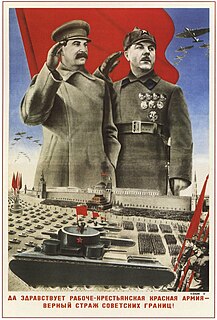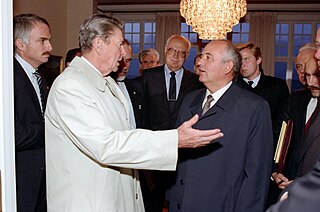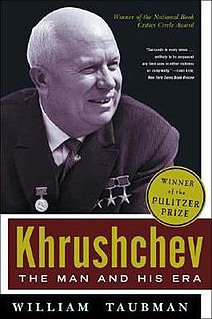Related Research Articles

Mikhail Sergeyevich Gorbachev is a Russian and former Soviet politician. The eighth and final leader of the Soviet Union, he was the General Secretary of the Communist Party of the Soviet Union from 1985 until 1991. He was also the country's head of state from 1988 until 1991, serving as the chairman of the Presidium of the Supreme Soviet from 1988 to 1989, chairman of the Supreme Soviet from 1989 to 1990, and president of the Soviet Union from 1990 to 1991. Ideologically, Gorbachev initially adhered to Marxism–Leninism, although he had moved towards social democracy by the early 1990s.

The Soviet Union, officially the Union of Soviet Socialist Republics (USSR), was a socialist state that spanned Eurasia during its existence from 1922 to 1991. It was nominally a federal union of multiple national republics; in practice its government and economy were highly centralized until its final years. The country was a one-party state governed by the Communist Party of the Soviet Union, with Moscow as its capital within its largest and most populous republic, the Russian SFSR. Other major urban centers were Leningrad, Kiev, Minsk, Tashkent, Alma-Ata and Novosibirsk. It was the largest country in the world, covering over 22,402,200 square kilometres (8,649,500 sq mi), and spanning eleven time zones.

Leonid Ilyich Brezhnev was a Soviet politician who led the Soviet Union as General Secretary of the governing Communist Party (1964–1982) and as Chairman of the Presidium of the Supreme Soviet. His 18-year term as general secretary was second only to Joseph Stalin's in duration. While Brezhnev's rule was characterised by political stability and significant foreign policy successes, it was also marked by corruption, inefficiency, economic stagnation, and rapidly growing technological gaps with the West.

The Cold War was a period of geopolitical tension between the United States and the Soviet Union and their respective allies, the Western Bloc and the Eastern Bloc, which began following World War II. Historians do not fully agree on its starting and ending points, but the period is generally considered to span the 1947 Truman Doctrine to the 1991 dissolution of the Soviet Union. The term cold war is used because there was no large-scale fighting directly between the two superpowers, but they each supported major regional conflicts known as proxy wars. The conflict was based around the ideological and geopolitical struggle for global influence by these two superpowers, following their temporary alliance and victory against Nazi Germany in 1945. Aside from the nuclear arsenal development and conventional military deployment, the struggle for dominance was expressed via indirect means such as psychological warfare, propaganda campaigns, espionage, far-reaching embargoes, rivalry at sports events and technological competitions such as the Space Race.

The Sino-Soviet split was the breaking of political relations between the People's Republic of China (PRC) and the Union of Soviet Socialist Republics (USSR), caused by doctrinal divergences that arose from their different interpretations and practical applications of Marxism–Leninism, as influenced by their respective geopolitics during the Cold War (1945–1991). In the late 1950s and early 1960s, Sino-Soviet debates about the interpretation of orthodox Marxism became specific disputes about the USSR's policies of national de-Stalinization and international peaceful coexistence with the Western world, which CPC chairman Mao Zedong decried as revisionism. Against that ideological background, China took a belligerent stance towards the West, and publicly rejected the USSR's policy of peaceful coexistence between the Eastern and Western blocs. In addition, Beijing resented the closer Soviet ties with India, and Moscow feared Mao was too nonchalant about the horrors of nuclear war.

The General Secretary of the Central Committee of the Communist Party of the Soviet Union was the leader of the Communist Party of the Soviet Union (CPSU) that by the late 1920s had evolved into the most powerful of the Central Committee's various positions. Seldom in Soviet history would any other office trump the authority of General Secretary. From 1929 until the union's dissolution, the holder of the office was the de facto leader of the Soviet Union, because the post controlled both the CPSU and the Soviet government. The power of the office can be traced to Joseph Stalin when he elevated the office to overall command of the Communist Party and by extension the whole Soviet Union. Once Stalin outmaneuvered Leon Trotsky and removed his major political rivals through purges, the General Secretary exercised total control of party and nation. Nikita Khrushchev renamed the post First Secretary in 1953 as part of de-stalinization. The change was reverted in 1966. The office grew out of less powerful secretarial positions within the party: Technical Secretary (1917–1918), Chairman of the Secretariat (1918–1919), and Responsible Secretary (1919–1922).

The military history of the Soviet Union began in the days following the 1917 October Revolution that brought the Bolsheviks to power. In 1918 the new government formed the Red Army, which then defeated its various internal enemies in the Russian Civil War of 1917–22. The years 1918–21 saw defeats for the Red Army in the Polish–Soviet War (1919–21) and in independence wars for Estonia (1918–20), Latvia (1918–20) and Lithuania (1918–19). The Red Army invaded Finland ; fought the Battles of Khalkhin Gol of May–September 1939 against Japan and its client state Manchukuo; it was deployed when the Soviet Union, in agreement with Nazi Germany, took part in the invasion of Poland in September 1939, and occupied the Baltic States, Bessarabia and Northern Bukovina. In World War II the Red Army became a major military force in the defeat of Nazi Germany and conquered Manchuria. After the war, it occupied East Germany and many nations in central and eastern Europe, which became satellite states in the Soviet bloc.

After the Russian Revolution, in which the Bolsheviks took over the old Russian Empire in 1918, they faced enormous odds against the German Empire and eventually negotiated terms to pull out of World War I. They then went to war against both domestic and international enemies in the bitter civil war. Tsarist Russia was reorganized as the Soviet Union in 1922 with Vladimir Lenin in charge. At first, it was treated as an unrecognized pariah state because of its repudiating of tsarist debts and threats to destroy capitalism at home and around the world. By 1922, Moscow had repudiated the goal of world revolution, and sought diplomatic recognition and friendly trade relations with the capitalist world, starting with Britain and Germany. Finally in 1933, the United States gave recognition. Trade and technical help from Germany and the United States arrived in the late 1920s. After Lenin died in 1924, Joseph Stalin, became leader. He transformed the country in the 1930s into an industrial and military power. After the appeasement policy of Britain and France, the Soviet Union shifted from a strategy of antifascist collective security to one of national security. By signing the Molotov–Ribbentrop Pact with Germany in August 1939, relations improved and the Soviet Union delayed the German invasion while occupying nearby territories in Eastern Europe. Despite repeated warnings that Hitler planned to invade, Stalin was caught by surprise in June 1941 when Nazi Germany invaded the Soviet Union and reached the outskirts of Leningrad and Moscow. However, the Soviet Union proved strong enough to defeat Nazi Germany, with help from its key allies.

The Reykjavík Summit was a summit meeting between U.S. President Ronald Reagan and General Secretary of the Communist Party of the Soviet Union Mikhail Gorbachev, held in Reykjavík, Iceland, on 11–12 October 1986. The talks collapsed at the last minute, but the progress that had been achieved eventually resulted in the 1987 Intermediate-Range Nuclear Forces Treaty between the United States and the Soviet Union.

This is an English language bibliography of scholarly books and articles on the Cold War. Because of the extent of the Cold War, the conflict is well documented.

The relations between the United States of America and the Union of Soviet Socialist Republics (1922–1991) succeeded the previous relations between the Russian Empire and the United States from 1776 to 1917 and preceded modern-day relations between the Russian Federation and the United States that began in 1992. Full diplomatic relations between both countries were established in 1933, which was late due to the countries' mutual hostility. During World War II, both countries were briefly allies. At the end of the war, the first signs of post-war mistrust and hostility began to appear between the two countries, escalating into the Cold War; a period of tense hostile relations, with periods of détente.
Robert William Davies, better known as R. W. Davies or Bob Davies, was a British historian, writer and professor of Soviet Economic Studies at the University of Birmingham.
In Russia, efforts to build communism began after Tsar Nicholas II lost his power during the February Revolution, which started in 1917, and ended with the dissolution of the USSR in 1991. The Provisional Government was established under the liberal and social-democratic government; however, the Bolsheviks refused to accept the government and revolted in October 1917, taking control of Russia. Vladimir Lenin, their leader, rose to power and governed between 1917 and 1924. The Bolsheviks formed the Russian Soviet Federative Socialist Republic, or the Union of Soviet Socialist Republics, marking the beginning of the Russian Civil War between the revolutionary Reds and the counter-revolutionary Whites. In 1922, the Communist Reds were victorious and formed the Soviet Union, making Russia communist. Lenin died in 1924, starting a power struggle which ended with Joseph Stalin seizing power. He was the leader of the Communist Party until 1953. He conducted the Great Purge to remove opponents of his dominance. Stalin died in 1953, and the Soviet Union went through "De-Stalinisation" under the new leader Nikita Khrushchev, though his attempts to improve the lives of ordinary citizens were often ineffective. Khrushchev ruled through the years of the Cold War. Leonid Brezhnev was appointed leader in 1964. Brezhnev governed the era without economic reforms, which led to a national economic decline by the mid-1970s. Yuri Andropov gained power in 1982 and tried to improve the economy by increasing management effectiveness but without making changes to the principles of a socialist economy. Andropov later died in 1984, fifteen months after gaining power.

The history of Soviet Russia and the Soviet Union reflects a period of change for both Russia and the world. Though the terms "Soviet Russia" and "Soviet Union" often are synonymous in everyday speech, when referring to the foundations of the Soviet Union, "Soviet Russia" properly refers to the few years between the October Revolution of 1917 and the creation of the Soviet Union in 1922. However, before 1922 the Soviet Union was multiple independent Soviet Republics, e.g. the RSFSR and Ukrainian SSR. At its peak the USSR consisted of the Russian SFSR, Byelorussian SSR, Ukrainian SSR, Lithuanian SSR, Latvian SSR, Estonian SSR, Georgian SSR, Kazakh SSR, and others, as well as multiple Satellite States. These satellite states included the Polish Peoples Republic, East Germany, and other members of the Warsaw Pact.

The Khrushchev Thaw is the period from the mid-1950s to the mid-1960s when repression and censorship in the Soviet Union were relaxed, and millions of political prisoners were released from Gulag labor camps due to Nikita Khrushchev's policies of de-Stalinization and peaceful coexistence with other nations. The term was coined after Ilya Ehrenburg's 1954 novel The Thaw ("Оттепель"), sensational for its time.

Khrushchev: The Man and His Era is a 2003 biography of Soviet leader Nikita Khrushchev. Written by William Taubman, the book is the first in-depth and comprehensive American biography of Khrushchev. Taubman was the recipient of the 2004 Pulitzer Prize for Biography or Autobiography, as well as the 2004 National Book Critics Circle Award. The author spent almost 20 years researching the life of Khrushchev in preparation to write the book. Extensive research was made possible through access to archives in Russia and Ukraine, which were opened to the public following the collapse of the Soviet Union. In addition to printed materials and documentation, he spent time engaging Khrushchev's children and extended relatives, resulting in over 70 personal interviews. Taubman presents a historical narrative and study of the life of Nikita Khrushchev, the Soviet leader who succeeded Joseph Stalin. The book concludes with Khrushchev's death on September 11, 1971.
De-Stalinization consisted of a series of political reforms in the Soviet Union after the death of long-time leader Joseph Stalin in 1953, and the ascension of Nikita Khrushchev to power.

This is a select bibliography of post World War II English language books and journal articles about Stalinism and the Stalinist era of Soviet history. Book entries have references to journal reviews about them when helpful and available.

This is a select bibliography of English language books and journal articles about the Post-Stalinist era of Soviet history. A brief selection of English translations of primary sources is included. The sections "General Surveys" and "Biographies" contain books; other sections contain both books and journal articles. Book entries have references to journal articles and reviews about them when helpful.
References
- ↑ Martin McCauley. Encyclopædia Britannica. Retrieved 1 June 2015.
- ↑ Martin McCauley. Limehouse Group of Analysts, July, 2004. Retrieved 1 June 2015.
- ↑ Bare Bones and Bones to Pick: The Ideology of Summarizing the Cold War. Roger Chapman, H-Net, February 1999. Retrieved 1 June 2015.